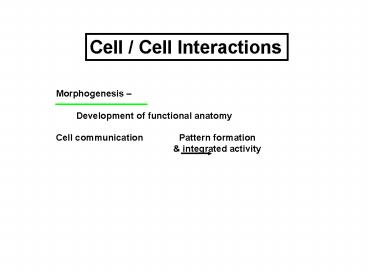Cell Cell Interactions - PowerPoint PPT Presentation
1 / 43
Title:
Cell Cell Interactions
Description:
Cell / Cell Interactions. Morphogenesis. Development of ... Newt. Frog. Area of presumptive. oral ectoderm. Presumptive Oral. ectoderm. Mouse embryo ... – PowerPoint PPT presentation
Number of Views:897
Avg rating:3.0/5.0
Title: Cell Cell Interactions
1
Cell / Cell Interactions
Morphogenesis Development of
functional anatomy Cell communication
Pattern formation
integrated activity
2
Micromeres Macromeres
Cleavage
3
Cell / Cell Interactions
Morphogenesis Development of
functional anatomy Cell communication
Pattern formation
integrated activity
4
- Chemotaxis
- Haptotaxis
- Galvanotaxis
5
Disruption of the tryptophan gradient around live
eggs prevents navigation
Free amino acid L-tryptophan directed
chemotaxis
Selectively digests tryptophan as it is secreted
Requires a natural gradient
Elimination of chemical gradient
Tryosine control for effects of
elevating aromatic amino acids
- Red abalone -
Riffell, J. A. et al. J Exp Biol
20022051439-1450
6
Chemotaxis vs. Haptotaxis ?
Development of the Pronephric duct
7
Galvanotaxis
Ca
Ca
Ca
Ca
---
Ca
8
Differential cell adhesion
9
Townes Holtfreter - 1955
Fig. 3.23, pg. 68
10
Steinberg Thermodynamic Differential Cell
Adhesion Model
11
Selective Affinity changes during development
?
Fig. 3.24, pg. 69
12
Themodynamic Model of Cell Interaction
13
Differential cell adhesion
Fig. 3.27, pg. 72
14
Knee
Mid-thigh
Wrist
Fig. 18.24a, pg. 579
15
Temporal changes in the cell membrane during
morphogenesis
16
Monoclonal Ab to isolate protein for
determination of gene
17
Tripeptide binding sequence arginine-glycine-as
partate
Homophilic binding
Protease cleaves Talin
binding/ uncoupling with actin
Integrins - Binding to extracellular matrix
Cadherins Ca dependent
Fig. 3.28, pg. 72
Fig. 6.32, pg. 166
18
Induction
- Primary embryonic induction
- specific to events associated with
- gastrulation (neural tube formation)
- in amphibians
- Secondary tissue induction
- permissive vs. instructive
19
Induction vs. Determination
20
Inductive Event 1 tissue capable of
inducing a stimulus 2 tissue competent
of responding to stimulus
Y
cell surface receptors
intracellular signaling pathway
target genes
O
21
Gonad Development and Primary Sex Determination
22
Primary Induction
Fibronectin ECM on ectodermal cells
Integrins on mesodermal cells
Presumptive Ectoderm
Presumptive Endoderm
Dorsal Blastopore Lip
Presumptive Mesoderm
Gastrulation in Amphibians
Fig. 10.7, pg. 296
23
Normal Dorsal Blastopore Lip
Hans Spemann Hilde Mangold 1924
Fig. 10.19, pg. 306
24
Organizer and Mesoderm Induction
Presumptive Ectoderm Presumptive Endoderm
Xnr protein concentration
Morphogen
Synergistic
Fig. 10.26, pg. 312
25
Inductive Event 1 tissue capable of
inducing a stimulus 2 tissue competent
of responding to stimulus
Y
cell surface receptors
intracellular signaling pathway
target genes
O
26
3-dimensional body plan layed down
Archenteron roof
Head
Tail
Tail
Gastrulation in Amphibians
Fig. 10.7E, pg. 296
27
Regional Specificity of Induction
Fig. 10.34, pg. 318
28
Ectodermal origin
Mesodermal origin
Fig. 6.7, pg. 145
29
Leg mesoderm under chest ectoderm
Thigh mesoderm under wing ectoderm
Ankle mesoderm under thigh ectoderm
30
Regionally specific mesodermal induction of
ectoderm
31
Genetic Specificity of Induction
Area of presumptive oral ectoderm
Presumptive Oral ectoderm
Newt
Frog
Fig. 6.8, pg. 145
32
Mouse embryo
Chick embryo
1
2
3
1 chick presumptive corneal epithelium chick
skin mesoderm
2 chick presumptive corneal epithelium mouse
skin mesoderm
3 chick jaw epithelium D16 mouse jaw mesoderm
33
(No Transcript)
34
The Development of Archosaurian
First-Generation Teeth in a Chicken Mutant
Matthew P. Harris, Sean M. Hasso, Mark W.J.
Ferguson, and John F. Fallon 21
February 2006, Volume 16, Issue 4, Pages 371-377
A and D Alligator embryo B and E
ta2 chicken mutant
Mutant Wild-type sibling
- Talpid2 chicken mutant (autosomal recessive
mutation which affects development of many organ
systems) - Dont survive past embryonic stage
35
Wild - type
ta2 mutant
Frontonasal process
Boundary signaling center
Oral cavity
Ect.
Mes.
Competent mesenchymal tooth cells
(Fibroblast growth factor 8) (Bone morphogenetic
protein 4) (Sonic hedgehog gene)
Ect.
Mes.
Gene expression during early development is
shifted along the oral/aboral boundary in ta2
mutants to redefine this boundary
Both avian ectoderm and mesenchyme have
potential to participate in tooth
development
Developmental repositioning of epithelium with
signaling potential so that it overlies
mesenchyme which is competent to form teeth.
36
Review Induction
Inductive signal Competency
Response
Obtained
New Receptor Pool
Repression of Inhibition
Differentiation
Lose competence to 1st inductive signal /
gain competence to new inductive signal
37
(Spemann 1901)
Double-Assurance hypothesis
Fig. 6.1, pg. 140
38
Lens Induction in Amphibians
Fig. 6.4a, pg. 142
39
Fig. 6.4b, pg. 142
Competence / Bias / Determination
Fig. 6.5a, pg. 143
40
Presumptive cells
Mark individual cell with vital dye
Becomes brain cell thuspresumptive
neural ectoderm
41
1 endoderm mesoderm stimulates Otx2
expression - defines compentency of ectoderm to
respond to neural plate signals 2 anterior
neural plate stimulates Pax6 expression - defines
competency of ectoderm to respond to optic
vesicle signals 3 optic vesicle stimulates Sox
3 expression - precipitating lens formation
Fig. 6.4b, pg. 142
Competence / Bias / Determination
Fig. 6.5a, pg. 143
42
Epithelium for corneal formation
43
- Lens induces ectoderm
- Ectoderm secretes
- collagen (primary stroma)
- Endothelial cells (of neural
- crest origin) use collagen
- as substrate and secrete
- hyaluronic acid causing
- collagen to swell
- Mesenchymal tissue
- (neural crest cell origin too)
- move in
- Mesenchymal tissue
- secretes hyaluronidase
- shrinking stroma
- Thryoxine stimulates
- corneal differentiation
Corneal Development































